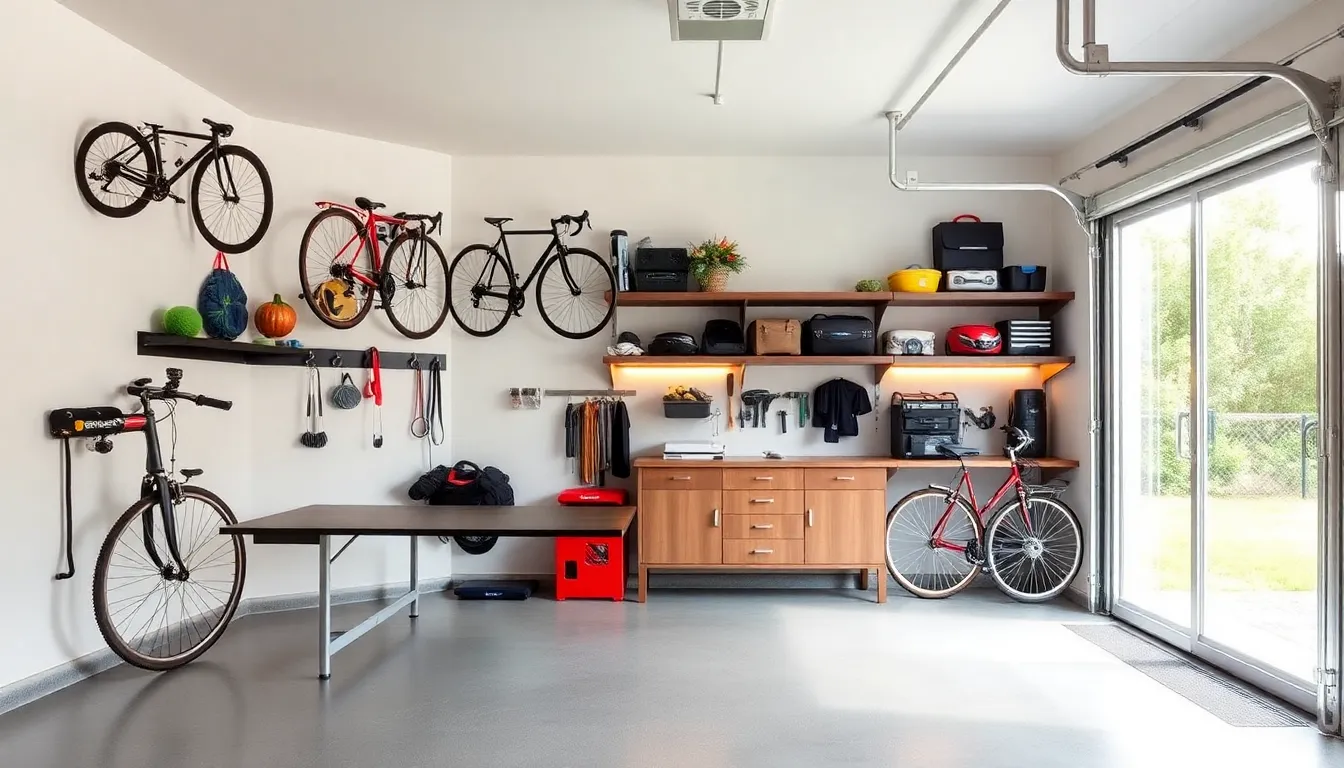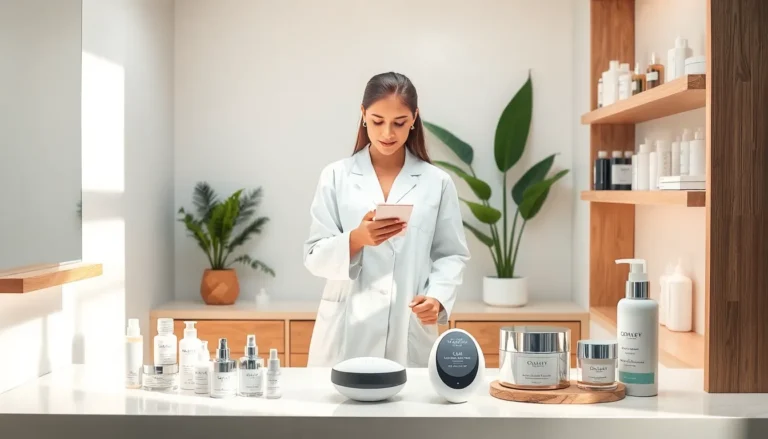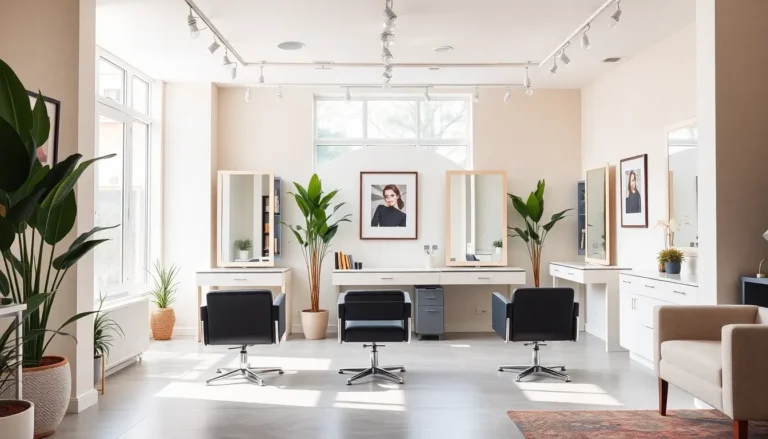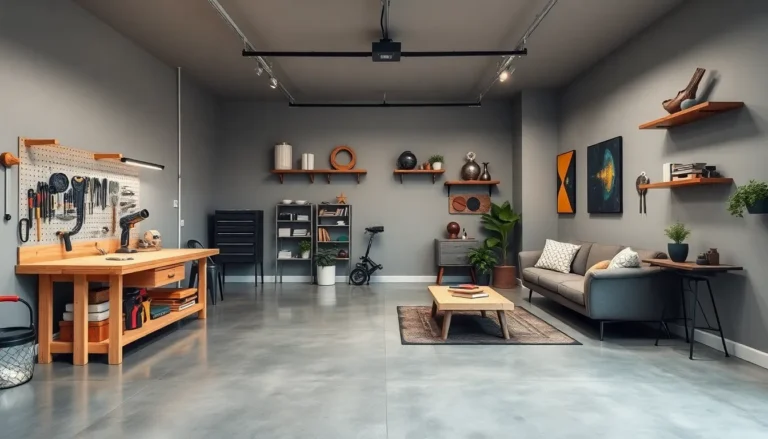Ever walked into a garage and wondered if it could do more than house your car and act as a temporary storage unit for clutter? Well, it can. Interior garage design might not sound like the most glamorous topic, but with a pinch of creativity and a dash of organization, it can become a versatile haven for hobbies, storage, or even a workshop. Welcome to the world of possibilities. Let’s explore how to transform that mundane space into something fabulous without losing any of the practical elements along the way.
Table of Contents
ToggleUnderstanding Garage Space Utilization

Garages are often overlooked when it comes to home design, typically relegated to the role of a cluttered catch-all. But, understanding garage space utilization is the first step to transforming it into a multipurpose area. Assess the current layout: it’s crucial to identify what’s working and what’s not. A garage often holds more than just vehicles: tools, bicycles, seasonal decorations, and sports equipment can all clutter the space. This is where a strategic approach to organizing and utilizing each square foot can make a huge difference.
He or she might start by evaluating how the space is currently being used. One effective method is to categorize items and decide what you truly need access to. This can reveal areas of underutilization or redundancy. For instance, consider vertical storage solutions or wall-mounted racks. These ideas can breed not only a clean aesthetic but also enhance functionality. Placing hooks or shelves along the walls can keep gear off the floor, making the garage feel more open and usable.
Also, think about future needs. Is there a possibility of needing more workspace? Will that old bike ever be ridden again? Assessing not just current but future usage is key in creating an adaptable garage layout.
Maximizing Storage Solutions
Storage solutions within the garage might seem straightforward, but where creativity meets functionality sparks true innovation. First, it’s essential to take inventory. He or she might consider clear bins or labeled boxes to keep tools, supplies, and seasonal items neatly organized. Color-coded boxes can not only simplify finding what’s needed but also add a pop of color to a typically dreary space.
Consider utilizing all available space. Overhead storage can be a game changer. He or she can install a sturdy ceiling rack to store infrequently used items, clearing valuable floor space for more essential uses. Wall-mounted cabinets can hide clutter and keep tools secure without sacrificing aesthetics. What about installing a pegboard? This fantastic tool allows users to hang smaller items, making them easily accessible while showcasing a bit of personality with the arrangement.
Plus to traditional solutions, this is a wonderful opportunity to get clever with DIY shelving ideas. Using reclaimed wood can add character while remaining budget-friendly. So, innovative storage solutions can boost efficiency and express style.
Creating a Functional Workspace
Creating a functional workspace in the garage opens doors to endless possibilities. Whether it’s for woodworking, crafting, or a general-purpose workspace, this area can be tailored to any need. Start by defining the workspace area. He or she can allocate a designated space where every tool is within arm’s reach. A sturdy workbench is a must-have: it provides both surface area and stability.
Also, optimizing tools’ storage can save time and frustration. A rolling tool cart, for instance, combines mobility with efficiency, allowing users to pull tools closer when working on projects. He or she should consider adding task lighting to brighten up the workspace. Aim for a combination of overhead lights and adjustable task fixtures to illuminate the workspace effectively.
Also, incorporating a small fridge or coffee station can create a comfortable retreat for those long project weekends. It’s all about making the space inviting while ensuring it remains practical. Painting the workspace a light color not only enhances brightness but can also improve mood, making it a delightful spot to spend time.
Incorporating Aesthetic Elements
The aesthetic of a garage may not seem significant, but it can drastically alter the feel of the space. When incorporating aesthetic elements, he or she can lean on personal style. For example, color choice plays a large role: a fresh coat of paint can breathe life into otherwise dreary walls. Bold colors can invigorate the space, while softer tones can bring tranquility.
Decorative accents like wall art or even shelving lined with plants can soften the industrial vibe of a garage. Hanging plants or succulents are great for adding a touch of nature, which can uplift the atmosphere. Also, consider using decor that reflects hobbies or interests. Vintage signage or tool displays can transform utilitarian objects into works of art.
Flooring also bears importance. Rubber flooring can be practical and easy to clean but consider using decorative mats to add warmth. The overall design should reflect an inviting atmosphere that encourages creativity while still providing functionality. So, merging aesthetics with practicality can light up the mundane.
Choosing the Right Lighting and Ventilation
Lighting and ventilation in a garage are pivotal, directly affecting comfort and usability. Inadequate lighting can quickly turn an ambitious project into a frustrating battle against shadows. Hence, a well-lit garage is essential. Overhead lights should be supplemented with task lighting to provide clarity where detailed work occurs.
Consider installing LED fixtures, which are energy-efficient and provide bright white light. He or she might also install motion-sensor lights for convenience and energy savings. Natural light should not be overlooked. If possible, adding windows or even a skylight can create a pleasant atmosphere and keep the garage feeling less like a dungeon.
Ventilation is equally as crucial, particularly in a workspace. Proper airflow helps mitigate fumes from paint or chemicals, promoting a healthier environment. Simple exhaust fans can serve this purpose, ensuring that fresh air circulates. So, a focus on lighting and ventilation can enhance the functionality and overall comfort of the garage.
Implementing Safety and Accessibility Features
Safety and accessibility in garage design shouldn’t take a back seat. When planning for safety, consider the types of projects that will be undertaken. Organizing tools while ensuring that hazardous materials are stored correctly can help mitigate accidents. He or she might use childproof locks on cabinets to keep children safe from potential hazards. Also, clearly labeled storage for chemicals or sharp tools promotes a responsible environment.
Accessibility is equally essential, particularly for those with mobility challenges. Ensure that pathways remain clear, allowing easy movement throughout the space. Implementing non-slip flooring can also be an effective safety measure. Besides, organizing items at different heights can help ensure that all tools and materials are within reach for everyone.
Eventually, prioritizing safety and accessibility can transform a garage from merely a functional space into one that truly accommodates all users.






